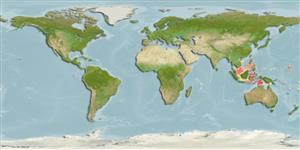>
Eupercaria/misc (Various families in series Eupercaria) >
Latilidae (Deepwater tilefishes)
Etymology: Branchiostegus: Greek, brangchia = gills + Greek, stego = roof, to cover (Ref. 45335).
More on author: Herre.
Issue
Validity of species not confirmed (Ref. 8991). Considered as nomen dubium by Dooley and Iwatsuki (2012:31, Ref. 89848).
Environment: milieu / climate zone / depth range / distribution range
Ökologie
seewasser demersal. Tropical
Western Central Pacific: known only from the type locality, a fish market in Narvacan, Ilocos Sur on the west coast of northern Luzon, Philippines.
Size / Gewicht / Alter
Maturity: Lm ? range ? - ? cm
Max length : 27.0 cm SL Männchen/unbestimmt; (Ref. 9884)
Known only from Herre's original description.
Life cycle and mating behavior
Geschlechtsreife | Fortpflanzung | Ablaichen | Eier | Fecundity | Larven
Herre, A.W.C.T., 1928. Three new Philippine fishes. Philipp. J. Sci. 35(1):31-37. (Ref. 9884)
IUCN Rote Liste Status (Ref. 130435: Version 2024-1)
Bedrohung für Menschen
Harmless
Nutzung durch Menschen
Tools
Zusatzinformationen
Download XML
Internet Quellen
Estimates based on models
Preferred temperature (Ref.
123201): 18.3 - 27.7, mean 26 °C (based on 133 cells).
Phylogenetic diversity index (Ref.
82804): PD
50 = 0.5000 [Uniqueness, from 0.5 = low to 2.0 = high].
Bayesian length-weight: a=0.00832 (0.00404 - 0.01712), b=3.11 (2.92 - 3.30), in cm total length, based on LWR estimates for this (Sub)family-body shape (Ref.
93245).
Trophic level (Ref.
69278): 3.5 ±0.5 se; based on size and trophs of closest relatives
Widerstandsfähigkeit (Ref.
120179): mittel, Verdopplung der Population dauert 1,4 - 4,4 Jahre. (Preliminary K or Fecundity.).
Fishing Vulnerability (Ref.
59153): Low vulnerability (23 of 100).
